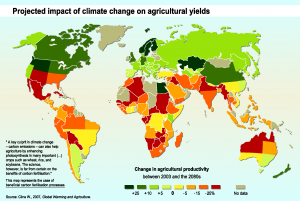
Table of Contents
Climate Change:
- Earth is warming day by and the effect of climate change is more real than ever.
- IPCC defines climate change as “Climate change refers to a statistically significant variation in either the mean state of the climate or in its variability, persisting for an extended period (typically decades or longer)”.
- However UNFCC describes climate change as the change in global atmosphere resulted due to human activities along with the natural climate variability which is bound to happen in periods of time.
- Climate change is more linked with the global warming, greenhouse gas emissions and other human activities.
- Climate change has affected human health, economy, and also threatens the food security.
Food Security:
- Food and Agriculture Organization (FAO) describes food security as the ‘‘situation that exists when all people, at all times, have physical, social, and economic access to sufficient, safe, and nutritious food that meets their dietary needs and food preferences for an active and healthy life’’
- Food security is not only limited to the trade of the food and its access but further food security is also about meeting up with the demand of food, assuring that the individual who are at more risk of losing their access to the food like the poor, farmers, children etc., are no more in risk and are provided with the adequate food to lead a healthy life. Food security also deals with converting the food into the nourishment or making the proper utilization of the food.
- Sub-Saharan African countries are highly vulnerable to the food insecurity due to climate change. Most of the Asian nation are in middle level risk and the southern and central America are in relatively lower
Effects of climate change on food security:
a) Effects on availability and production of the food:
- Climate change alters the agro-ecological conditions and effects the production and growth pattern of the crops
- Change in land quality, precipitation, temperature, availability of the gases in atmosphere greatly affects the crops
- Climate change hits the drier spots the most as the land becomes more dry and loses the productivity.
- Crops in temperate lands might increase the productivity due to increase in the temperature but however other conditions resulted due to climate change such as drought, unpredictable rainfall, heat waves, coastal storms however brings more devastation than the production.

- Although crop production increases 10% to 20% at 550ppm CO2, the nutritional quality decreases. Most crops do not survive at the high concentration of greenhouses gases.
- Increase in temperature is favorable for the pest and the insects. This increases the pest invasion in the agricultural fields.
- Beside the crops, climate change also effects the livestock, marine species and others.
b) Effects on the stability of the food supplies:
- Climate change results in extreme weather events such as floods, landslide, soil-erosion, cyclone, droughts, etc.
- These events affects the agricultural production and the pattern.
- They too affect in access and utilization of food thus disrupting the food security strategies of individual and government.
c) Effects on health and life:

- With the climate change many vectors borne (like malaria), water borne diseases increases.
- Warmer climate also increases the prevalence of food poisoning, diarrhea, salmonellosis etc.
- Climate change directly or indirectly forms the cycle of hunger, disease and poverty.
- Higher exposure of people to disease, added food insecurity, health problems, healthcare practices decreases their capacity to utilize the food.
d) Effects in the food access:
- Climate change can increase the price of the major crops.
- The change in the global agricultural pattern would alter the balance between food demand and the supply. With demand being much higher than the supply the price of the food are sure to increase.
- Those people who were already at the risk of losing their access to the food would be further more in risk.
- Poverty, hunger and malnourishment are more likely to increase and the poor are hit the hardest.
Challenges to mitigate the climate change:
- Strong global attention and action
- Strong political commitment at all levels
- Poverty
- Climate change is bound to happen to some extent
- Difficult to comprehend the understanding of climate change by the public
- Focus of government and stakeholders on other priority problems which has immediate result
- Need of bigger and long-term investment to address climate change
- Increasing unplanned industrialization
Strategies to cope up with the food insecurity:
Measures to cope up with the food insecurity can be summed up in three steps:
- Risk reduction
- Risk management
- Risk coping
1. Risk reduction
- One cannot undo the steps that has caused climate change but can definitely prevent it from getting worst. Risk reduction usually refers to the measures to reduce and prevent the emission of the greenhouse gases.
2. Risk management
- It refers to minimizing the effects of the climate change.
- Improve the irrigation facility
- Utilization of scientific tools, improvised seeds and fertilizers etc in agricultures.
- Improve agricultural research on drought tolerant crops.
3. Risk coping
- Disaster preparedness strategies
- Diversifying towards climatically optimal crop and livestock varieties, adjusting land use and cropping patterns
- Public policies that focuses more on the vulnerable and the marginalized groups.
- Collective efforts from the individual, governmental and global level to reduce the burden of climate change.
References and for more information:
http://www.pnas.org/content/pnas/104/50/19703.full.pdf
https://www.ipcc.ch/ipccreports/tar/wg1/518.htm
https://www.wfp.org/climate-change/climate-impacts
https://www.tandfonline.com/doi/pdf/10.3155/1047-3289.59.10.1194
https://www.ncbi.nlm.nih.gov/pubmed/19842327
http://library.fes.de/pdf-files/iez/08466.pdf
http://www.fao.org/family-farming/detail/en/c/284674/